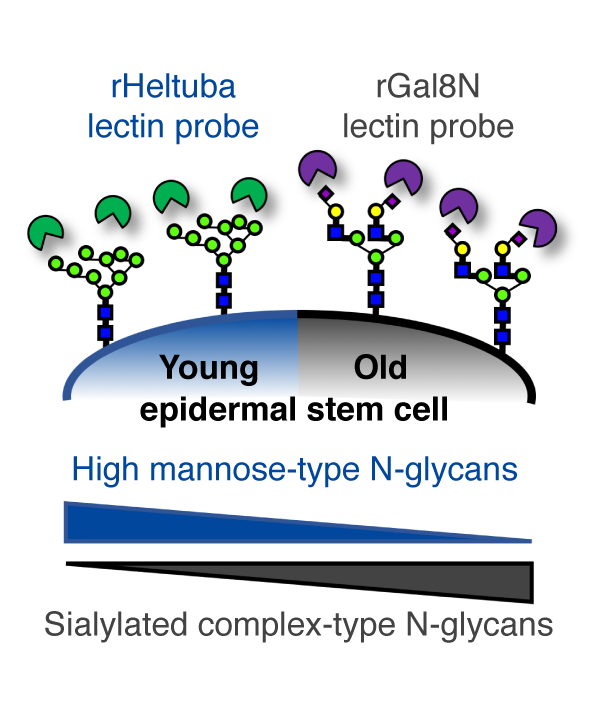- HOME
- News & Events
- Publications
- 【Publications】Glycome profiling by lectin microarray reveals dynamic glycan alterations during epide...
Publications
【Publications】Glycome profiling by lectin microarray reveals dynamic glycan alterations during epidermal stem cell aging
July 21 2020
Aiko Sada
Paper information
Lalhaba Oinam, Gopakumar Changarathil, Erna Raja, Yen Xuan Ngo, Hiroaki Tateno*, Aiko Sada*, Hiromi Yanagisawa (*Corresponding authors)
Glycome profiling by lectin microarray reveals dynamic glycan alterations during epidermal stem cell aging
Aging Cell 2020 July 18:e13190 doi: 10.1111/acel.13190
Highlights
-
Using lectin microarray, a platform for high-throughput glycome analysis, we demonstrate that epidermal stem cells undergo an age-related glycome shift from high mannose- to sialylated complex-type N-glycans.
-
The glycan alterations are detected by lectin probes, rHeltuba and rGal8N, which serve as potential biomarkers of skin aging.
Abstract
Aging in the epidermis is marked by a gradual decline in barrier function, impaired wound healing, hair loss, and an increased risk of cancer. This could be due to age-related changes in the properties of epidermal stem cells and defective interactions with their microenvironment. Currently, no biochemical tools are available to detect and evaluate the aging of epidermal stem cells. The cellular glycosylation is involved in cell-cell communications and cell-matrix adhesions in various physiological and pathological conditions. Here we explored the changes of glycans in epidermal stem cells as a potential biomarker of aging. Using lectin microarray, we performed a comprehensive glycan profiling of freshly isolated epidermal stem cells from young and old mouse skin. Epidermal stem cells exhibited a significant difference in glycan profiles between young and old mice. In particular, the binding of a mannose-binder rHeltuba was decreased in old epidermal stem cells, whereas that of an a2-3Sia-binder rGal8N increased. These glycan changes were accompanied by up-regulation of sialyltransferase, St3gal2 and St6gal1 and mannosidase Man1a genes in old epidermal stem cells. The modification of cell surface glycans by overexpressing these glycogenes leads to a defect in the regenerative ability of epidermal stem cells in culture. Hence, our study suggests the age-related global alterations in cellular glycosylation patterns and its potential contribution to the stem cell function. These glycan modifications detected by lectins may serve as molecular markers for aging, and further functional studies will lead us to a better understanding of the process of skin aging.

